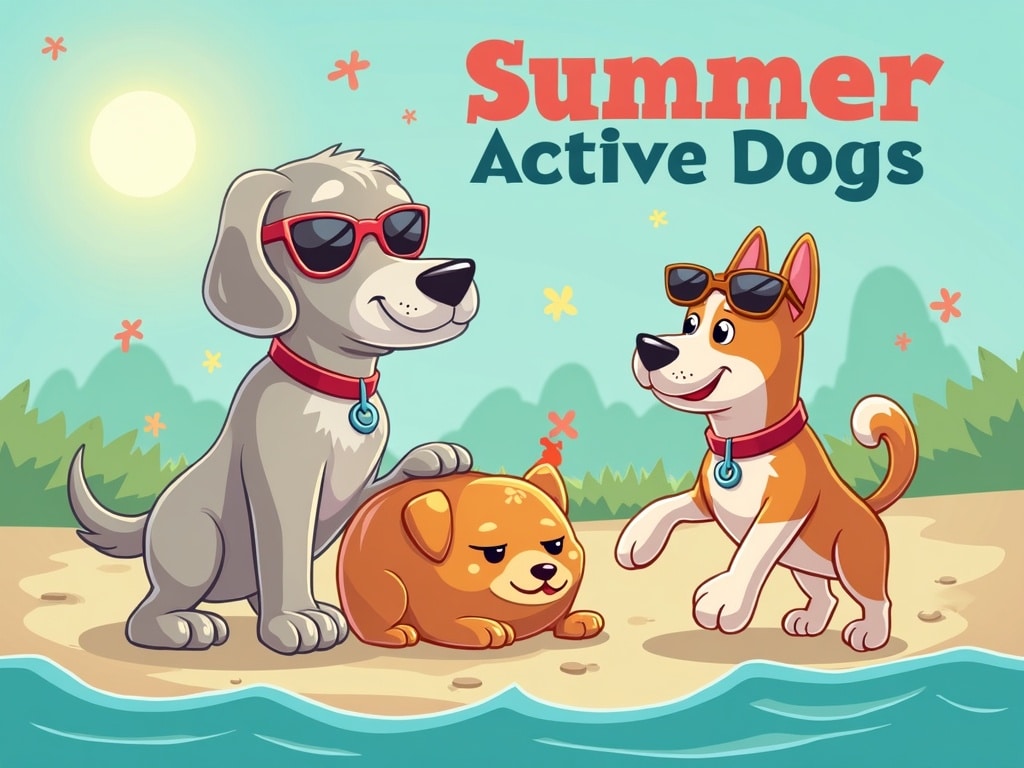Summer Safety Tips for Active Dogs: Keeping Your Pup Cool and Safe
The sun is shining, the birds are singing, and your dog is practically vibrating with excitement for outdoor adventures. Summer is prime time for active dogs and their owners, but it’s also a season that demands extra vigilance. From scorching pavements to hidden dangers in the water, the risks to your canine companion are real. But with a little planning and some essential knowledge, you can ensure your furry friend stays cool, safe, and happy all summer long.
Understanding Summer Risks for Dogs
Dogs don't sweat like humans. They primarily rely on panting to regulate their body temperature, which is a less efficient cooling system, especially in humid conditions. This makes them particularly vulnerable to overheating and heatstroke. Beyond the obvious heat risks, summer brings a host of other potential hazards:
- Heatstroke: A life-threatening condition where a dog's body temperature rises to dangerous levels.
- Dehydration: Losing fluids faster than they can be replenished.
- Paw Burns: Hot pavement can severely burn sensitive paw pads.
- Sunburn: Yes, dogs can get sunburned, especially those with light-colored fur.
- Water Hazards: Drowning risks in pools, lakes, and oceans, as well as potential for water intoxication.
- Toxic Algae Blooms: Blue-green algae in freshwater can be deadly.
- Parasites and Pests: Increased risk of fleas, ticks, and heartworm.
Beat the Heat: Keeping Your Dog Cool
The most crucial aspect of summer safety is preventing overheating. Here's how to keep your dog cool:
Time of Day Matters
Avoid strenuous activity during the hottest part of the day, typically between 10 am and 4 pm. Early morning and late evening are ideal times for walks and play sessions. Before heading out, check the pavement temperature. If it's too hot for your bare hand to hold for more than a few seconds, it's too hot for your dog's paws.
Provide Plenty of Water
Ensure your dog has access to fresh, cool water at all times. Carry a collapsible water bowl and a bottle of water on walks. Consider adding ice cubes to the water for an extra cooling boost. Some dogs enjoy flavored water, like diluted unsweetened chicken broth, to encourage them to drink more.
Cooling Gear is Your Friend
Invest in cooling vests, bandanas, and mats. These items are designed to absorb water and slowly release it, providing evaporative cooling. Look for lightweight, breathable options that won't trap heat. Dampen the gear with cool water before putting it on your dog. Another great option is a kiddie pool filled with cool water for your dog to relax in.
Create Shade
When outdoors, always provide access to shade. This could be a tree, an umbrella, or a portable dog tent. Even on a cloudy day, the sun's rays can be strong enough to cause overheating.
Recognizing and Responding to Heatstroke
Knowing the signs of heatstroke is critical for prompt action. Symptoms include:
- Excessive panting or difficulty breathing
- Drooling
- Weakness or lethargy
- Vomiting or diarrhea
- Bright red gums
- Seizures
- Collapse
If you suspect your dog has heatstroke, act immediately:
- Move your dog to a cool, shaded area.
- Offer small amounts of cool water (do not force it).
- Apply cool (not ice-cold) water to their body, focusing on the groin, armpits, and neck.
- Use a fan to help with evaporation
- Seek immediate veterinary attention. Heatstroke can be fatal, even with treatment.
Protecting Those Paws: Pavement Safety
Hot pavement can cause severe burns to a dog's paw pads. Here's how to protect them:
- The Seven-Second Rule: Place the back of your hand on the pavement for seven seconds. If it's too hot for you, it's too hot for your dog.
- Walk on Grass or Shady Paths: Opt for grassy areas or shady routes whenever possible.
- Dog Boots: Consider using dog boots to provide a protective barrier against the hot pavement. Make sure they fit properly to avoid discomfort or chafing.
- Paw Balm: Apply paw balm to moisturize and protect paw pads.

Water Safety: More Than Just Staying Afloat
Swimming can be a great way for dogs to cool off and exercise, but it's important to take precautions:
Supervise at All Times
Never leave your dog unattended near water, even if they are a strong swimmer. Currents, waves, and fatigue can quickly lead to trouble.
Start Slowly
Introduce your dog to water gradually. Let them get used to the feeling of being in the water and never force them to swim. Use positive reinforcement, like treats and praise, to encourage them.
Know Your Dog's Limits
Even strong swimmers can tire easily. Watch for signs of fatigue, such as slowed pace, labored breathing, or difficulty staying afloat. Take frequent breaks and ensure they have a safe place to exit the water.
Beware of Water Intoxication
Dogs can accidentally ingest too much water while swimming or playing in the water. This can lead to water intoxication (hyponatremia), a dangerous condition where the sodium levels in the body become dangerously diluted. Symptoms include vomiting, lethargy, staggering, and seizures. Limit the amount of time your dog spends retrieving toys in the water and discourage them from gulping water while swimming. Offer them treats frequently to prevent the intake of water.
Watch Out for Algae Blooms
Blue-green algae (cyanobacteria) can produce toxins that are harmful and even fatal to dogs. Avoid letting your dog swim in or drink from bodies of water with visible algae blooms. These blooms often look like pea soup or spilled paint on the water's surface.
Sun Protection for Dogs
Just like humans, dogs can get sunburned, especially those with short or light-colored fur. The most vulnerable areas are the nose, ears, and belly. Use a dog-specific sunscreen on these areas, especially if your dog will be spending extended time outdoors. Avoid sunscreens containing zinc oxide or PABA, as these can be toxic if ingested.
Protecting them from Parasites
Fleas, ticks, and mosquitoes are more prevalent during the summer months, posing a risk of Lyme disease, heartworm, and other illnesses. Talk to your veterinarian about the best preventative medications for your dog. Regularly check your dog for ticks after spending time outdoors, especially in wooded or grassy areas.
Additional Summer Safety Tips
- Never leave your dog in a parked car, even for a few minutes. Temperatures inside a car can rise rapidly, even on a mild day, leading to heatstroke and death.
- Be aware of hot surfaces, such as metal truck beds or dark asphalt.
- Adjust feeding schedules to avoid feeding your dog a large meal right before exercise.
- Consider a summer haircut for long-haired breeds, but avoid shaving them completely as their fur provides some protection from the sun.
- Learn pet first aid and CPR. Knowing how to respond in an emergency can save your dog's life.
Summer should be a time of fun and adventure for you and your dog. By taking these safety precautions, you can ensure that your furry friend stays healthy, happy, and safe throughout the season. So, grab that water bottle, pack the sunscreen, and get ready to make some unforgettable summer memories with your canine companion!

